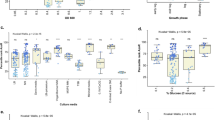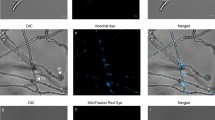Abstract
Phaeodactylum tricornutum is a model diatom, and its genomic sequence data and expressed sequence tag databases are available. This study was to discover a new endogenous promoter that drives strong constitutive expression of a protein of interest in P. tricornutum. To find promoter candidates, the intracellular proteins of P. tricornutum grown to stationary phase were extracted and identified by LC–MS/MS. Glutamine synthetase (GLNA) was one of the most abundantly expressed proteins during the stationary phase. Promoter is usually located on 5′ upstream region of open reading frame of the gene. Thus, two fragments of 5′ upstream region of the GLNA gene as putative promoters, 501 and 997 bp long, were amplified and cloned into enhanced Green Fluorescent Protein (eGFP) reporter systems. The constructed reporter systems were transformed into P. tricornutum and the eGFP expression levels were compared to those of reporter systems using the promoters of fcpA (fucoxanthin chlorophyll a/c binding protein A) and CIP1 (putative replication-associated proteins of a Chaetoceros lorenzianus-infecting DNA virus) as controls. The expression of eGFP driven by either GLNA promoter (501 and 997 bp) was linearly related to cell density, and eGFP was expressed constitutively regardless of the cultivation phase. The eGFP expression level driven by the GLNA promoters was at least 4 times higher than the fcpA-driven eGFP expression level at the stationary phase. The 501 and 997 bp regions of the GLNA promoter had similar activity patterns for transcribing the downstream gene. These results indicate that at least 501-bp region of the GLNA promoter can be used as a strong constitutive promoter in genetic engineering of P. tricornutum.



Similar content being viewed by others
References
Apt KE, Kroth-Pancic PG, Grossman AR (1996) Stable nuclear transformation of the diatom Phaeodactylum tricornutum. Mol Gen Genet 252:572–579
Bhaya D, Grossman AR (1993) Characterization of gene clusters encoding the fucoxanthin chlorophyll proteins of the diatom Phaeodactylum tricornutum. Nucleic Acids Res 21:4458–4466
Bowler C, Allen AE, Badger JH, Grimwood J, Jabbari K, Kuo A, Maheswari U, Martens C, Maumus F, Otillar RP, Rayko E, Salamov A, Vandepoele K, Beszteri B, Gruber A, Heijde M, Katinka M, Mock T, Valentin K, Verret F, Berges JA, Brownlee C, Cadoret JP, Chiovitti A, Choi CJ, Coesel S, De Martino A, Detter JC, Durkin C, Falciatore A, Fournet J, Haruta M, Huysman MJ, Jenkins BD, Jiroutova K, Jorgensen RE, Joubert Y, Kaplan A, Kroger N, Kroth PG, La Roche J, Lindquist E, Lommer M, Martin-Jezequel V, Lopez PJ, Lucas S, Mangogna M, McGinnis K, Medlin LK, Montsant A, Oudot-Le Secq MP, Napoli C, Obornik M, Parker MS, Petit JL, Porcel BM, Poulsen N, Robison M, Rychlewski L, Rynearson TA, Schmutz J, Shapiro H, Siaut M, Stanley M, Sussman MR, Taylor AR, Vardi A, von Dassow P, Vyverman W, Willis A, Wyrwicz LS, Rokhsar DS, Weissenbach J, Armbrust EV, Green BR, Van de Peer Y, Grigoriev IV (2008) The Phaeodactylum genome reveals the evolutionary history of diatom genomes. Nature 456:239–244
De Riso V, Raniello R, Maumus F, Rogato A, Bowler C, Falciatore A (2009) Gene silencing in the marine diatom Phaeodactylum tricornutum. Nucleic Acids Res 37:e96
Diaz-Santos E, de la Vega M, Vila M, Vigara J, Leon R (2013) Efficiency of different heterologous promoters in the unicellular microalga Chlamydomonas reinhardtii. Biotechnol Prog 29:319–328
Falciatore A, Casotti R, Leblanc C, Abrescia C, Bowler C (1999) Transformation of nonselectable reporter genes in marine diatoms. Mar Biotechnol 1:239–251
Guillard RRL (1975) Culture of phytoplankton for feeding marine invertebrates. In: Smith W, Chanley M (eds) Culture of marine invertebrate animals, 1st edn. Springer, New York, pp 29–60
Hamilton ML, Haslam RP, Napier JA, Sayanova O (2014) Metabolic engineering of Phaeodactylum tricornutum for the enhanced accumulation of omega-3 long chain polyunsaturated fatty acids. Metab Eng 22:3–9
Hempel F, Lau J, Klingl A, Maier UG (2011) Algae as protein factories: expression of a human antibody and the respective antigen in the diatom Phaeodactylum tricornutum. PLoS One 6:e28424
Kadono T, Miyagawa-Yamaguchi A, Kira N, Tomaru Y, Okami T, Yoshimatsu T, Hou L, Ohama T, Fukunaga K, Okauchi M, Yamaguchi H, Ohnishi K, Falciatore A, Adachi M (2015) Characterization of marine diatom-infecting virus promoters in the model diatom Phaeodactylum tricornutum. Sci Rep 5:18708
Kang K, Song DG, Lee EH, Lee KM, Park YG, Jung SH, Pan CH, Nho CW (2014) Secretome profiling reveals the signaling molecules of apoptotic HCT116 cells induced by the dietary polyacetylene gymnasterkoreayne B. J Agric Food Chem 62:2353–2363
Kinsella RJ, Kahari A, Haider S, Zamora J, Proctor G, Spudich G, Almeida-King J, Staines D, Derwent P, Kerhornou A, Kersey P, Flicek P (2011) Ensembl BioMarts: a hub for data retrieval across taxonomic space. Database (Oxford) 2011 p bar030
Maheswari U, Jabbari K, Petit J-L, Porcel BM, Allen AE, Cadoret J-P, Martino AD, Heijde M, Kaas R, Roche JL, Lopez PJ, Martin-Jézéquel V, Meichenin A, Mock T, Parker MS, Vardi A, Armbrust EV, Weissenbach J, Katinka M, Bowler C (2010) Digital expression profiling of novel diatom transcripts provides insight into their biological functions. Genom Biol 11:R85
Pelzer-Reith B, Freund S, Schnarrenberger C, Yatsuki H, Hori K (1995) The plastid aldolase gene from Chlamydomonas reinhardtii: Intron/exon organization, evolution, and promoter structure. Mol Gen Genet 248:481–486
Qin S, Lin H, Jiang P (2012) Advances in genetic engineering of marine algae. Biotechnol Adv 30:1602–1613
Saade A, Bowler C (2009) Molecular tools for discovering the secrets of diatoms. Bioscience 59:757–765
Seo S, Jeon H, Hwang S, Jin E, Chang KS (2015) Development of a new constitutive expression system for the transformation of the diatom Phaeodactylum tricornutum. Algal Res 11:50–54
Shevchenko A, Tomas H, Havlis J, Olsen JV, Mann M (2006) In-gel digestion for mass spectrometric characterization of proteins and proteomes. Nat Protoc 1:2856–2860
Siaut M, Heijde M, Mangogna M, Montsant A, Coesel S, Allen A, Manfredonia A, Falciatore A, Bowler C (2007) Molecular toolbox for studying diatom biology in Phaeodactylum tricornutum. Gene 406:23–35
Stevens DR, Roehaix J-D, Purton S (1996) The bacterial phleomycin resistance gene ble as a dominant selectable marker in Chlamydomonas. Mol Gen Genet 251:23–30
Yao Y, Lu Y, Peng K-T, Huang T, Niu Y-F, Xie W-H, Yang W-D, Liu J-S, Li H-Y (2014) Glycerol and neutral lipid production in the oleaginous marine diatom Phaeodactylum tricornutum promoted by overexpression of glycerol-3-phosphate dehydrogenase. Biotechnol Biofuels 7:1–9
Zaslavskaia LA, Martek JCL, Kroth PG, Grossman AR, Apt KE (2000) Transformation of the diatom Phaeodactylum tricornutum (Bacillariophyceae) with a variety of selectable marker and reporter genes. J Phycol 36:379–386
Acknowledgements
This research was performed as part of the project titled ‘Development and industrialization of high value cosmetic raw materials from marine microalgae,’ funded by the Ministry of Oceans and Fisheries, Korea, and was supported by an intramural Grant (2Z04690) from KIST Gangneung Institute of Natural Products.
Author information
Authors and Affiliations
Corresponding author
Electronic supplementary material
Below is the link to the electronic supplementary material.
Rights and permissions
About this article
Cite this article
Erdene-Ochir, E., Shin, BK., Huda, M.N. et al. Cloning of a novel endogenous promoter for foreign gene expression in Phaeodactylum tricornutum . Appl Biol Chem 59, 861–867 (2016). https://doi.org/10.1007/s13765-016-0235-y
Received:
Accepted:
Published:
Issue Date:
DOI: https://doi.org/10.1007/s13765-016-0235-y




